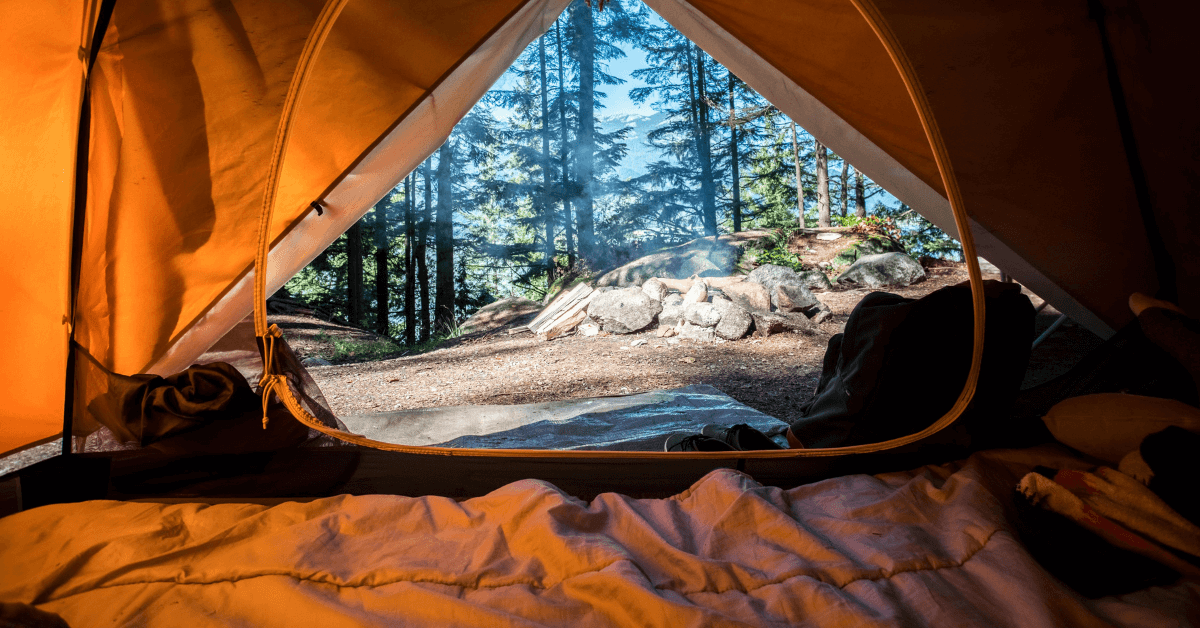Outdoor enthusiasts know that camping can be a truly magical experience, especially when the weather is just right. But when temperatures start to drop and the ground gets chilly, that magic can quickly turn into misery. To ensure a comfortable and enjoyable camping experience, it’s important to insulate the bottom of your tent.
The purpose of this article is to give you an in-depth understanding of tent floor insulation and provide you with different methods you can use to insulate the bottom of your tent. Whether you’re a seasoned camper or just starting out, you’ll learn about the different types of insulation materials, the importance of insulation, and how to properly use and care for your insulation.
Without further ado, let’s jump right in and start with a straight to the point answer highlighting points we’ll review throughout the post.
How Do You Insulate the Bottom of a Tent?
To insulate the bottom of a tent, you can use a tent insulation pad, underquilt, or groundsheet, which are placed between the tent floor and the ground to provide insulation and warmth. You can also use commercially available insulation options or create a DIY solution by using materials such as foam mats, carpet, or closed-cell foam.
Understanding Tent Floor Insulation
Insulating the bottom of your tent is all about trapping warm air inside and keeping cold air out. But before we dive into the different methods of insulating your tent floor, let’s take a closer look at what insulation is and how it works.
Different Types of Insulation Materials
There are a variety of materials that can be used to insulate the bottom of your tent, including reflective foam, closed-cell foam, and synthetic insulation. Each type of material has its own unique benefits and drawbacks, so it’s important to understand the options available to you before choosing one.
How Insulation Works in a Tent
Insulation works by trapping warm air inside and preventing it from escaping. When you place an insulation material between your tent floor and the ground, it creates a barrier that keeps the warmth inside and keeps the cold air out. The insulation material also helps to distribute weight evenly, which can prevent damage to your tent floor.
Factors to Consider When Choosing Insulation
When choosing an insulation material for your tent, there are a few factors to consider, including:
- The type of camping you’ll be doing (backpacking, car camping, etc.)
- The type of terrain you’ll be camping on (sand, rock, snow, etc.)
- The temperature range you’ll be camping in
- The weight and bulk of the insulation material
- The price and durability of the insulation material
By considering these factors, you can determine the best type of insulation material for your specific camping needs and ensure a warm and comfortable camping experience.
3 DIY Methods of Insulating a Tent Floor
For those who like to take things into their own hands, there are several DIY methods you can use to insulate the bottom of your tent. Let’s take a look at three of the most popular methods: reflective foam insulation, creating a tent footprint, and using a tent insulation pad.
1. Reflective Foam Insulation
One of the simplest and most effective ways to insulate the bottom of your tent is by using reflective foam insulation. This type of insulation is made from a layer of foam covered in a reflective material that bounces heat back toward you. To use this method, simply place the insulation material between your tent floor and the ground.
Pros:
- Reflective foam insulation is lightweight and easy to pack
- It provides effective insulation and can help keep you warm in cold weather
- It’s also affordable and readily available
Cons:
- Reflective foam insulation may not provide enough insulation for extremely cold temperatures
- It’s not very durable and may need to be replaced frequently
2. Creating a Tent Footprint
Another DIY option for insulating the bottom of your tent is to create a tent footprint. A tent footprint is a piece of durable material, such as plastic or Tyvek, that you place under your tent to protect it from abrasion and moisture. To use this method, simply place the tent footprint under your tent and then set up your tent on top of it.
Pros:
- A tent footprint provides protection from abrasion and moisture
- It’s a simple and inexpensive option for insulating your tent
- You can make your own tent footprint using materials you have at home
Cons:
- A tent footprint may not provide enough insulation for extremely cold temperatures
- It may not provide enough protection from moisture in wet conditions
3. Using a Tent Insulation Pad
If you’re looking for a little extra warmth and comfort, you can use a tent insulation pad. A tent insulation pad is a specially designed pad that fits under your sleeping bag and provides insulation and cushioning. To use this method, simply place the insulation pad under your sleeping bag inside your tent.
Pros:
- A tent insulation pad provides extra insulation and cushioning for a more comfortable sleeping experience
- It’s a lightweight and compact option that’s easy to pack and carry
- Some tent insulation pads can also be used as a camping mat outside of your tent
Cons:
- Tent insulation pads can be expensive
- Some may not provide enough insulation for extremely cold temperatures
3 Best Commercial Tent Floor Insulation Options

For those who prefer a ready-made solution, there are several commercial options available for insulating the bottom of your tent. Let’s take a look at three popular options: tent insulation pads, underquilts, and groundsheets.
1. Tent Insulation Pads
One of the most popular commercial options for insulating the bottom of your tent is a tent insulation pad. Tent insulation pads are specially designed pads that fit under your sleeping bag and provide insulation and cushioning. Some tent insulation pads are designed to fit specific tent models, while others can be used with any tent.
Pros:
- Tent insulation pads are a convenient, ready-made solution for insulating your tent
- They provide extra insulation and cushioning for a more comfortable sleeping experience
- Some tent insulation pads can also be used as a camping mat outside of your tent
Cons:
- Tent insulation pads can be expensive
- Some may not provide enough insulation for extremely cold temperatures
- They may not be as durable as other options
2. Underquilts
An underquilt is a type of insulation that hangs beneath your camping hammock to provide insulation and protect you from cold drafts. Underquilts are a popular choice for those who enjoy camping in a hammock and want to stay warm in cold weather.
Pros:
- Underquilts provide extra insulation and protect you from cold drafts
- They’re a great choice for those who enjoy camping in a hammock
- Some underquilts are lightweight and compact, making them easy to pack and carry
Cons:
- Underquilts are designed specifically for use with camping hammocks and may not be compatible with other types of tents
- They can be expensive
- Some may not provide enough insulation for extremely cold temperatures
3. Groundsheets
A groundsheet is a piece of material, such as plastic or Tyvek, that you place under your tent to protect it from abrasion and moisture. Some groundsheets are designed to provide insulation as well, making them a good option for those who want to keep the bottom of their tent warm.
Pros:
- Groundsheets provide protection from abrasion and moisture
- Some groundsheets provide insulation as well
- They’re an affordable and convenient option for those who want to keep the bottom of their tent warm
Cons:
- Groundsheets may not provide enough insulation for extremely cold temperatures
- They may not provide enough protection from moisture in wet conditions
- Some groundsheets may not be as durable as other options
Related: What Color Tent Is Best For Sun Protection?
How to Properly Use and Care for Tent Insulation
No matter which method you choose for insulating the bottom of your tent, proper use and care are essential to ensuring that your insulation lasts and continues to provide the protection and comfort you need. Here are some tips for getting the most out of your tent insulation:
1. Proper placement
When placing your insulation, be sure to follow the manufacturer’s instructions for proper placement. This will ensure that your insulation provides the maximum amount of protection and comfort.
2. Protect from moisture
Moisture is the enemy of insulation, so be sure to keep your insulation dry and protected from moisture. If you’re using a tent insulation pad, underquilt, or groundsheet, make sure to keep them dry and protected from rain, snow, and other forms of moisture.
3. Store carefully
When you’re not using your tent insulation, be sure to store it carefully to protect it from damage. Store your insulation in a dry, protected place where it won’t be exposed to moisture, sunlight, or other elements that can cause damage.
4. Clean and maintain
Regular cleaning and maintenance of your tent insulation can help to extend its life and ensure that it continues to provide the protection and comfort you need. Clean your insulation according to the manufacturer’s instructions and make any necessary repairs or replacements as needed.
With these tips for proper use and care, you’ll be able to get the most out of your tent insulation and ensure that it lasts for many camping trips to come. So go ahead, and stay cozy and comfortable, no matter what Mother Nature has in store!
Conclusion – How Do You Insulate the Bottom of a Tent?
Insulating the bottom of a tent involves placing a layer of insulation between the tent floor and the ground to increase warmth and comfort. This can be achieved through the use of commercially available options such as insulation pads, underquilts, or groundsheets. DIY solutions, such as using foam mats, carpet, or closed-cell foam, are also possible.
Whether you choose a simple groundsheet, an underquilt, or a more sophisticated insulation pad, proper use and care will help to ensure that your insulation lasts and provides the protection and comfort you need.
So gear up, hit the trails, and enjoy the great outdoors in comfort and style!
